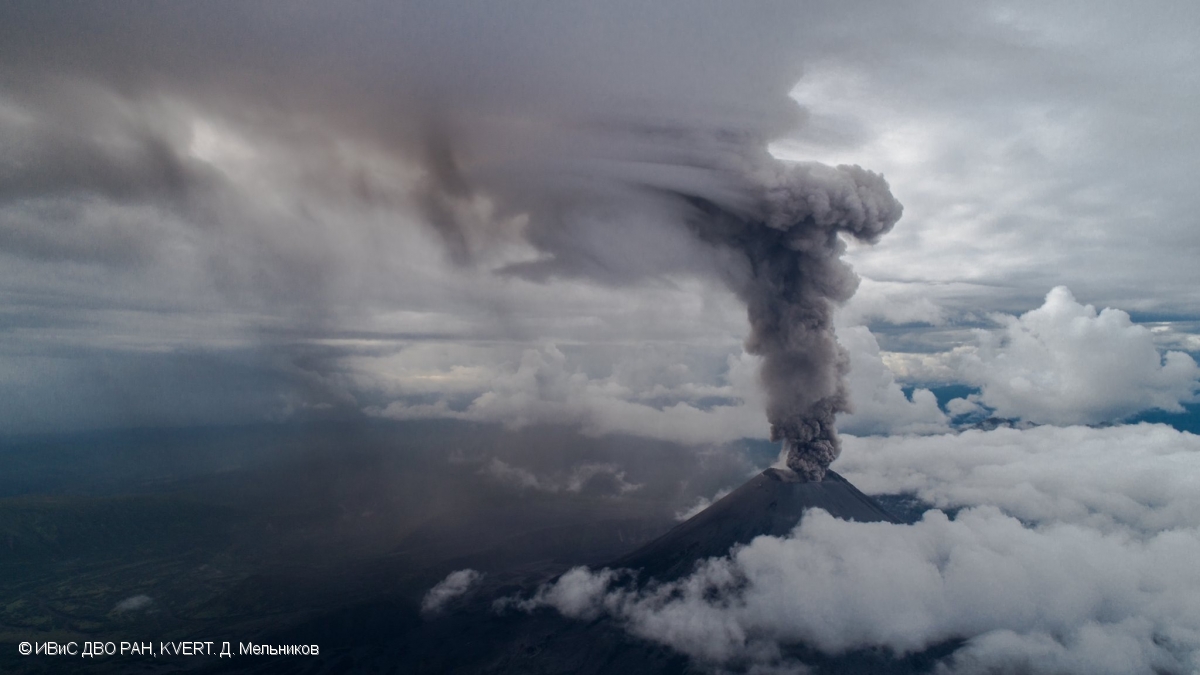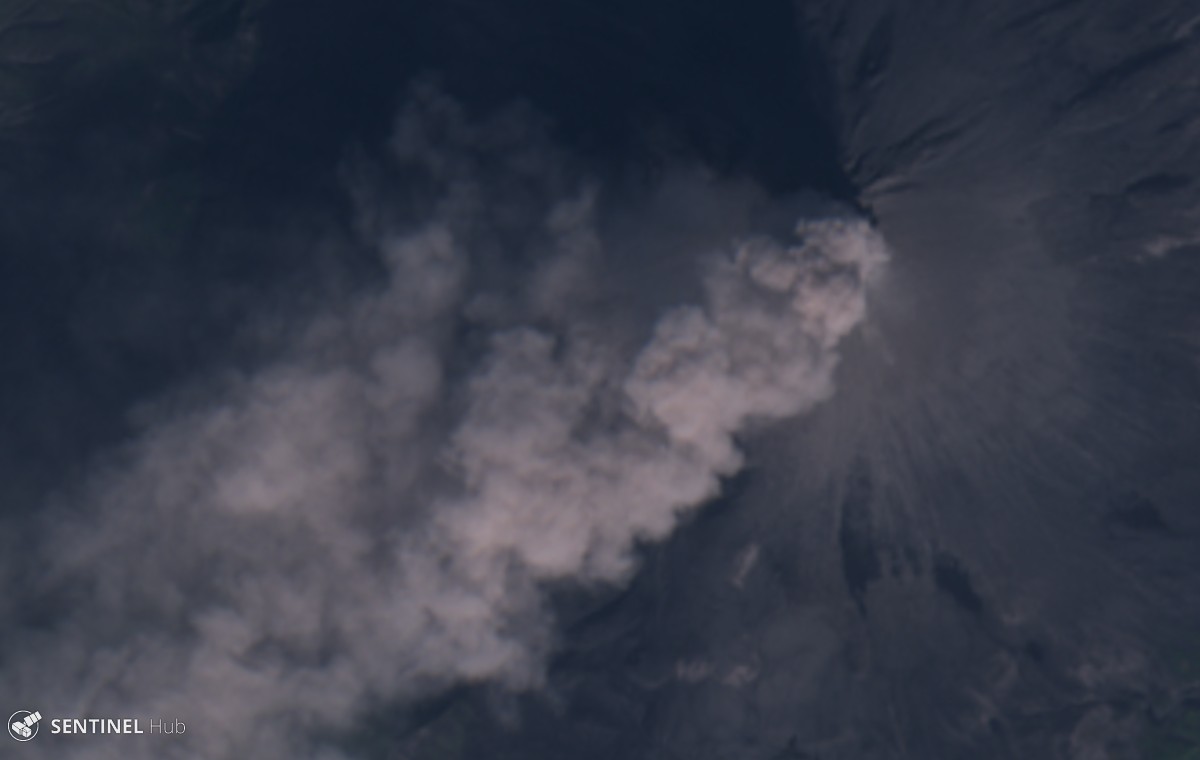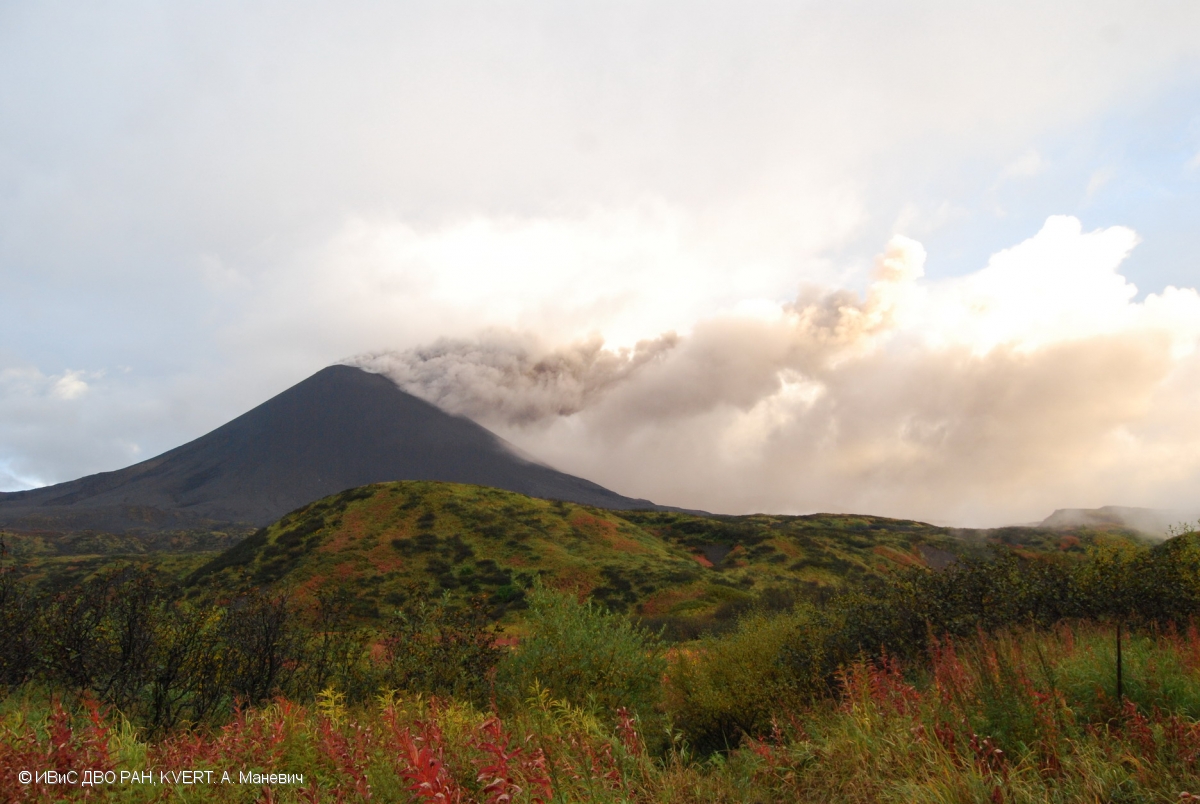Report on Karymsky (Russia) — November 2019
Bulletin of the Global Volcanism Network, vol. 44, no. 11 (November 2019)
Managing Editor: Edward Venzke.
Research and preparation by Paul Berger.
Karymsky (Russia) Moderate explosive activity with ash plumes through 24 September 2019
Please cite this report as:
Global Volcanism Program, 2019. Report on Karymsky (Russia) (Venzke, E., ed.). Bulletin of the Global Volcanism Network, 44:11. Smithsonian Institution. https://doi.org/10.5479/si.GVP.BGVN201911-300130
Karymsky
Russia
54.049°N, 159.443°E; summit elev. 1513 m
All times are local (unless otherwise noted)
Eruptive activity at Karymsky has been frequent since 1996, with moderate ash explosions, gas-and-steam emissions, and thermal anomalies. The latest eruptive period began in mid-February 2019 (BGVN 44:05) when explosions resumed after more than four months of quiet, producing an ash plume that extended 55 km downwind. Intermittent explosive activity continued until 24 September 2019. The volcano is monitored by the Kamchatka Volcanic Eruptions Response Team (KVERT).
Ash plumes were reported during the second half of February and the first half of March 2019 (BGVN 44:05). During May-September 2019 similar activity continued, with ash plumes being generated at least every few days (table 12). Though not included in the weekly KVERT report as notable events, obvious ash plumes were also seen in Sentinel-2 imagery on 22 July and photographed from an aircraft on 23 July. Volcanologists doing fieldwork on 14 August observed an ash plume rising to 5 km altitude (figure 44). A week later, during 20-22 August, explosions generated ash plumes as high as 6 km altitude that were visible in satellite imagery (figure 45). Although not noted in KVERT reports, a photo from 9 September showed a plume blowing downwind directly from the summit crater (figure 46). No significant ash plumes were reported by KVERT after 24 August, but the last ash explosion was recorded on 24 September.
Table 12. Notable ash plumes reported from Karymsky during May-October 2019. All dates are in UTC. Courtesy of KVERT.
| Date | Observations |
| 06-07 May 2019 | Gas-and-steam plume containing ash rose to 2-2.2 km in altitude and drifted 105 km SE and SW. |
| 21 May 2019 | Ash plume drifted 9 km SW. |
| 24 May 2019 | Ash plume identified in satellite images drifted 45 km NE. |
| 13-17 Jul 2019 | Ash plumes drifted 60 km in multiple directions. |
| 25 Jul 2019 | Ash plume drifted 134 km SE. |
| 26 Jul 2019 | Ash plume drifted 60 km SE. |
| 03-05 Aug 2019 | Ash plumes drifted 180 km SE and NW. |
| 06 Aug 2019 | Ash plume rose 2-2.5 km in altitude and drifted about 17 km NW. |
| 14 Aug 2019 | Volcanologists observed explosions and ash plumes that rose to 5 km altitude. Satellite images showed ash plumes drifting E and SSE that same day. |
| 20-22 Aug 2019 | Ash plumes visible in satellite images drifted 500 km SW. Explosions on 21 August produced ash plumes to 6 km altitude. |
| 23-24 Aug 2019 | Ash plumes drifted 51 km SE. |
 |
Figure 44. Aerial photo showing an ash plume rising to 5 km altitude from Karymsky 14 August 2019. Photo by D. Melnikov; courtesy of IVS FEB RAS, KVERT. |
 |
Figure 45. Satellite image from Sentinel-2 (natural color) of an ash plume at Karymsky on 21 August 2019. Courtesy of Sentinel Hub Playground. |
 |
Figure 46. Photo showing explosive activity at Karymsky at 1920 UTC on 9 September 2019. Photo by A. Manevich; courtesy of IVS FEB RAS, KVERT. |
During May-October 2019, thermal anomalies were detected with the MODIS satellite instruments analyzed using the MODVOLC algorithm only on 25 July (2 pixels) and 21 August (10 pixels). Consistent with both observations, KVERT noted ash explosions on those dates. The MIROVA (Middle InfraRed Observation of Volcanic Activity) volcano hotspot detection system, also based on analysis of MODIS data, detected numerous hotspots in May, none in June, 3 in July, 5 in August, and none in September or October. KVERT reported that a thermal anomaly was visible in satellite images on most, if not all, days when not obscured by clouds.
The Aviation Color Code remained at Orange (the second highest level on a four-color scale) until 3 October, when KVERT reduced it to Yellow, after which moderate gas-and-steam activity continued.
Geological Summary. Karymsky, the most active volcano of Kamchatka's eastern volcanic zone, is a symmetrical stratovolcano constructed within a 5-km-wide caldera that formed during the early Holocene. The caldera cuts the south side of the Pleistocene Dvor volcano and is located outside the north margin of the large mid-Pleistocene Polovinka caldera, which contains the smaller Akademia Nauk and Odnoboky calderas. Most seismicity preceding Karymsky eruptions originated beneath Akademia Nauk caldera, located immediately south. The caldera enclosing Karymsky formed about 7600-7700 radiocarbon years ago; construction of the stratovolcano began about 2000 years later. The latest eruptive period began about 500 years ago, following a 2300-year quiescence. Much of the cone is mantled by lava flows less than 200 years old. Historical eruptions have been vulcanian or vulcanian-strombolian with moderate explosive activity and occasional lava flows from the summit crater.
Information Contacts: Kamchatka Volcanic Eruptions Response Team (KVERT), Far Eastern Branch, Russian Academy of Sciences, 9 Piip Blvd., Petropavlovsk-Kamchatsky, 683006, Russia (URL: http://www.kscnet.ru/ivs/kvert/); Institute of Volcanology and Seismology, Far Eastern Branch, Russian Academy of Sciences (IVS FEB RAS), 9 Piip Blvd., Petropavlovsk-Kamchatsky 683006, Russia (URL: http://www.kscnet.ru/ivs/eng/); Hawai'i Institute of Geophysics and Planetology (HIGP) - MODVOLC Thermal Alerts System, School of Ocean and Earth Science and Technology (SOEST), Univ. of Hawai'i, 2525 Correa Road, Honolulu, HI 96822, USA (URL: http://modis.higp.hawaii.edu/); MIROVA (Middle InfraRed Observation of Volcanic Activity), a collaborative project between the Universities of Turin and Florence (Italy) supported by the Centre for Volcanic Risk of the Italian Civil Protection Department (URL: http://www.mirovaweb.it/); Sentinel Hub Playground (URL: https://www.sentinel-hub.com/explore/sentinel-playground).

